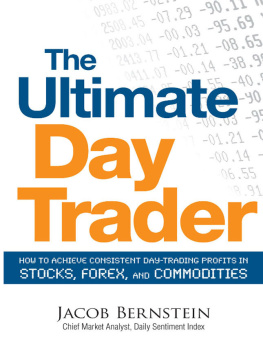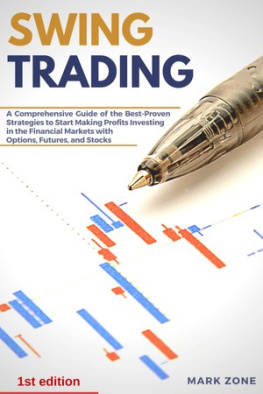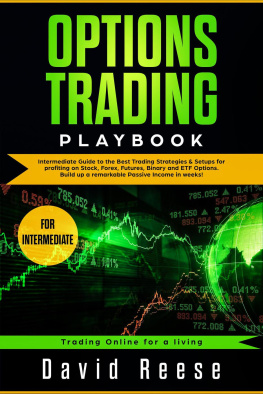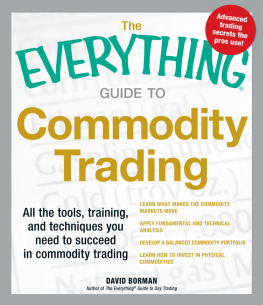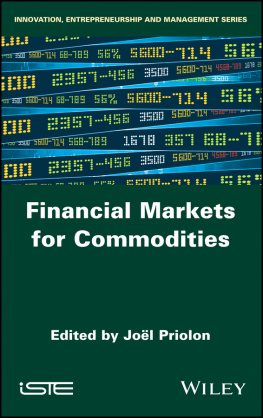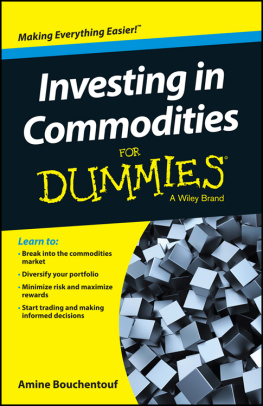Trading Commodities and Financial Futures
A Step-by-Step Guide to Mastering the Markets
George Kleinman
Vice President, Publisher: Tim Moore
Associate Publisher and Director of Marketing: Amy Neidlinger
Executive Editor: Jim Boyd
Editorial Assistant: Pamela Boland
Operations Specialist: Jodi Kemper
Marketing Manager: Megan Graue
Cover Designer: Alan Clements
Managing Editor: Kristy Hart
Project Editor: Jovana Shirley
Copy Editor: Kitty Wilson
Proofreader: Sheri Replin
Indexer: Word
Wise Publishing Services
Compositor: Gloria Schurick
Manufacturing Buyer: Dan Uhrig
2013 by Pearson Education, Inc.
Publishing as FT Press
Upper Saddle River, New Jersey 07458
This book is sold with the understanding that neither the author nor the publisher is engaged in rendering legal, accounting, or other professional services or advice by publishing this book. Each individual situation is unique. Thus, if legal or financial advice or other expert assistance is required in a specific situation, the services of a competent professional should be sought to ensure that the situation has been evaluated carefully and appropriately. The author and the publisher disclaim any liability, loss, or risk resulting directly or indirectly, from the use or application of any of the contents of this book.
FT Press offers excellent discounts on this book when ordered in quantity for bulk purchases or special sales. For more information, please contact U.S. Corporate and Government Sales, 1-800-382-3419, .
Company and product names mentioned herein are the trademarks or registered trademarks of their respective owners.
All rights reserved. No part of this book may be reproduced, in any form or by any means, without permission in writing from the publisher.
Printed in the United States of America
First Printing: March 2013
ISBN-10: 0-13-336748-7
ISBN-13: 978-0-13-336748-5
Pearson Education LTD.
Pearson Education Australia PTY, Limited.
Pearson Education Singapore, Pte. Ltd.
Pearson Education Asia, Ltd.
Pearson Education Canada, Ltd.
Pearson Educacin de Mexico, S.A. de C.V.
Pearson EducationJapan
Pearson Education Malaysia, Pte. Ltd.
The Library of Congress cataloging-in-publication data is on file.
Praise for Trading Commodities and Financial Futures, Third Edition
Congratulations to George Kleinman for writing a comprehensive futures compendium that should be mandatory reading for anyone considering futures trading. Kleinman dispels the myth that the individual trader always loses against the Goliaths in the markets.
Mary Cashman, Head of International Operations, Global Commodity Intelligence
Discipline and execution are the two most important and difficult aspects in trading. George Kleinman offers the solutions to the problems, and they are superb. Clear, crisp writing that will keep you reading and help you become a superior trader.
Yiannis G. Mostrous, Editor, Wall Street Winners, Financial Advisory
Without a doubt the best book I have read on the industry! Perfect for the novice speculator, yet comprehensive enough for the seasoned veteran to refer back to time and again. The trader who has been around awhile will enjoy reading the stories. Believe me, they are true!
Joseph M. Orlick, The Chicago Board of Trade
To Sherri
Contents
Important Risk Disclosures
Before you trade with real money, familiarize yourself with the risks.
Commodity futures trading is speculative and involves substantial risks, and you should only invest risk capital.
You can lose a substantial amount or all your investment, and you should carefully consider whether such trading is suitable for you in light of your financial condition.
The high degree of leverage that is obtainable in commodity trading can work against you as well as for you, and the use of leverage can lead to large losses as well as large gains.
If the market moves against your position, to maintain your position, you may on short notice be called upon by your broker to deposit additional margin money. If funds are requested, and you do not provide them within the prescribed time, your position may be liquidated at a loss, and you will be liable for any resulting deficit in your account. Under certain market conditions, you may find it difficult or impossible to liquidate a position. This can occur, for example, when the market makes a limit move. The placement of contingent orders, such as a stop-loss or stop-limit order, will not necessarily limit your losses to the intended amount.
There is no guarantee that the concepts presented in this book will generate profits or avoid losses.
Past results are not necessarily indicative of future results.
Acknowledgments
My sincere thanks to these former pit traders whose stories made for entertaining and informative contributions to this work: William G. Salatich, Jr., from the cattle pit, Joe Orlick from the corn pit, and Joseph Santagata and James Gallo from the copper pit. Thanks to my editors at PearsonJim Boyd, Jovana Shirley, and Kitty Wilsonfor making my thoughts flow much better. Jim, thank you for persuading me to do this latest edition. I did the best I could, and the result is the best to date. Thanks to the people at CQG who made the charts possible. Thanks to my best clients, who choose to put up with me, and my beloved wife, Sherri, who has no choice.
About the Author
George Kleinman is the president of Commodity Resource Corp., a futures advisory and trading firm that assists individual traders and corporate hedgers. George has a track record of success in the commodity futures business that spans more than 30 years.
A graduate of Ohio State, with an MBA from Hofstra University, George entered the commodity trading business with Merrill Lynch Commodities in 1979. When he left Merrill to start his own trading firm, George was a member of The Golden Circle (the top 10 commodity brokers internationally).
From 1983 to 1995, Commodity Resource was located on the trading floor of the Minneapolis Grain Exchange, where George held multiple memberships and served on the MGE board of directors. George was also a member of the COMEX Exchange for over a decade.
George has been featured for his trading in national publications and has lectured at major financial conferences regarding his trading techniques. He is the author of four previous books on commodities and futures trading and is an active trader for clients as well as his own account. George has developed his own proprietary trading techniques, some of which are highlighted in this edition. He can be reached via email at .
In 1995, George and his family moved to northern Nevada, and he now trades from an office overlooking beautiful Lake Tahoe.
Introduction
It is not the strongest of the species that survives, nor the most intelligent. It is the one that is the most adaptable to change.
Charles Darwin
New Yorks oldest commodity exchange, the New York Cotton Exchange, was established in 1870. For over a century, traders packed the cotton trading pit. They would discuss weather and crop reports, and they would make and lose fortunes. On a rainy Friday, October 19, 2012, the floor traders in cotton (as well as in coffee, cocoa, sugar, and orange juice) donned their trading jackets and yelled out their bids and offers for the last time. You see, this was the final day of open-outcry trading. The following Monday, for the first time since 1870, every trade in these markets was matched by computers.
I found this passing of an era sad. The best stories in this book emanate from the days of the floor traders. Human stories make for more entertaining reading than rogue computer algorithms (which is why I kept them in this edition).


